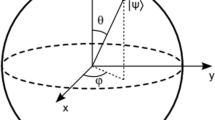Abstract
To enhance security in today’s computerized environment, communication must go above the boundaries of protocols. On the one extreme, improvements in encryption technology have been achieved, while the integrity of traditional techniques has indeed been repeatedly violated on another. In an online shopping, financial activity, or exchanging message communication via networks, safe transmission or activity should be considered at all times. The traditional cryptography’s integrity is frequently reliant on computational limitations. The safety of the RSA system, one of most frequently used public-key encryption technique, is predicated on factoring’s claimed difficulty. As a result, traditional encryption is followed more by possibility of unanticipated developments that may be hacked or attacked in quantum code-breaking technology and techniques. In the proposed system of quantum key distribution, the Trojan horse attack and time-shift attack are discussed. Quantum key distribution (QKD) is often recognized as a way to provide encrypted systems or communication services that assure communication security and reliability. Algorithms based on the concepts of quantum key distribution have showed promise in the pursuit for a higher security approach. So, the proposed quantum key distribution (QKD), the best aspect of quantum cryptography, decides to make cryptography unconditionally secure in communication of the networks. This suggested system also addresses quantum key distribution protocols in the context of significant network loss, as well as different threats and countermeasures that are taken into concern. They produce a safe key by using traditional post-processing techniques like error checking and safety amplification. By using protocols, these keys can be utilized for making transmission completely trustworthy.
Access this chapter
Tax calculation will be finalised at checkout
Purchases are for personal use only
Similar content being viewed by others
References
Campagna M et al (2015, June) Quantum safe cryptography and security. In: European Telecommunications Standards Institute (ETSI), ISBN No. 97910-92620-03-0
Rivest RL, Shamir A, Adleman LM (1978) A method of obtaining digital signatures and public-key cryptosystems. Commun ACM 21:120–126
Shor PW (1994) Algorithms for quantum computation: discrete logarithms and factoring. In: Goldwasser S (ed) Proceedings of 35th annual symposium on foundations of computer science. IEEE Computer Society Press, pp 124–134
Huttner B, Imoto N, Gisin N, Mor T (1995) Quantum cryptography with coherent states. Phys Rev A 51:1863–1869
Hwang W-Y (2003) Quantum key distribution with high loss: toward global secure communication. Phys Rev Lett 91:057901
Wang X-B (2005) Beating photon-number-splitting attack in practical quantum cryptography. Phys Rev Lett 94:230503
Makarov V, Anisimov A, Skaar J (2006) Effects of detector efficiency mismatch on security of quantum cryptosystems. Phys Rev A 74(2):022313
Makarov V, Skaar J (2007) Faked states attack using detector efficiency mismatch on SARG04, phase-time, DPSK, and Ekert protocols. arXiv preprint quant-ph/0702262
Vinay SE, Kok P (2018) Extended analysis of the Trojan-horse attack in quantum key distribution. Phys Rev A 97(4):042335
Lucamarini M, Choi I, Ward MB, Dynes JF, Yuan ZL, Shields AJ (2015) Practical security bounds against the trojan-horse attack in quantum key distribution. Phys Rev X 5(3):031030
Lutkenhaus N (2000) Security against individual attacks for realistic quantum key distribution. Phys Rev A 61:052304
Scarani V, Acin A, Ribordy G, Gisin N (2004) Quantum cryptography protocols robust against photon number splitting attacks for weak laser pulse implementations. Phys Rev Lett 92:057901
Qi B, Fung C-HF, Lo H-K, Ma X (2007) Time-shift attack in practical quantum cryptosystems. Quant Inf Comp 7:73–82
Author information
Authors and Affiliations
Corresponding author
Editor information
Editors and Affiliations
Rights and permissions
Copyright information
© 2023 The Author(s), under exclusive license to Springer Nature Singapore Pte Ltd.
About this paper
Cite this paper
Gampala, V., Maram, B., Suja Alphonse, A. (2023). Secured Quantum Key Distribution Encircling Profuse Attacks and Countermeasures. In: Dutta, P., Chakrabarti, S., Bhattacharya, A., Dutta, S., Piuri, V. (eds) Emerging Technologies in Data Mining and Information Security. Lecture Notes in Networks and Systems, vol 491. Springer, Singapore. https://doi.org/10.1007/978-981-19-4193-1_22
Download citation
DOI: https://doi.org/10.1007/978-981-19-4193-1_22
Published:
Publisher Name: Springer, Singapore
Print ISBN: 978-981-19-4192-4
Online ISBN: 978-981-19-4193-1
eBook Packages: Intelligent Technologies and RoboticsIntelligent Technologies and Robotics (R0)




